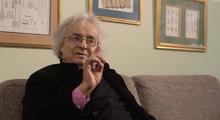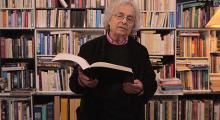Themes
Video Type
“We need images to cross the boundary of the unutterable.” The moving story of Günther Uecker – a legendary German artist, who expresses his artistic belief by means of a hammer and nails, thus reflecting his dark experiences from World War II.
“The graves were shallow, but it was hard work, and we vomited a lot.” In his early teens, during World War II, Uecker – who lived on an island in the Baltic Sea – was given the grueling task of burying bodies that had washed up on the beach following a bombardment by the British, a traumatic experience that never left him and came to influence him as an artist. It was also during the war that Uecker had his first encounter with hammering nails, having to nail shut the door and the window shutters of his house in order to protect his mother and two sisters against Russian soldiers. Later, when beginning his “intrusive” practice of adding nails to paintings, Uecker feels that this was a response to the war, as well as a desire to re-establish a closeness to people: “… we, as children of these events, so to speak, as inheritors of the guilt, who knew what had happened then… tried to find reasons, a new reason for living.”
As a young artist, Uecker realized that all kinds of materials were suitable for making a work of art: “It’s about taking the reality of everyday encounters with material that’s lying on the street and creating an expression of life, a cipher, a symbol, an instrument, not a sculpture but an instrument like a knife and fork with which we can eat art.” Because the source of art was rooted in raw, unadorned everyday life, it was also a way of embedding it in the present, while simultaneously confronting “the lies” of the illusions in past paintings: “To create these works using such means was a testament to our claim on life…”
“Boundaries are fictional, and when I reach them I jump over… But when you keep doing that in a visual mania it carries on into infinity.” Uecker believes that if one “works unconsciously” and repeatedly, something distinctive will eventually emerge through exhaustion, much like in fieldwork, which Uecker – who has a farming background – is greatly inspired by. His work is driven by a continuous search for something unidentified that he knows is there. In continuation of this, he never looks at a work or makes any corrections: “… it’s never seen and merely felt. And then it stands there as a testimony to my existence in that moment.”
Günther Uecker (b. 1930) is a German sculptor, painter, and installation artist. Uecker was a prominent member of the group ZERO – a movement, forged in the late 1950s that fostered artistic discovery by promoting a new environment unconstrained by past artistic traditions. Since 1956, Uecker increasingly used nails in his artistic practice, hammering nails into pieces of furniture, musical instruments and household objects, and later combining nails with light and creating his series of light nails and kinetic nails. His nail-relief works exceed the limits of the two-dimensional plane and create a new realm for the vision to explore the calculated patterns of light and shadow. Uecker’s work can be found in the collections of major institutions worldwide, among them the ZERO Foundation and Museum Kunst Palast in Düsseldorf, Stedelijk Museum in Amsterdam, Museum of Modern Art in New York, Museum of Contemporary Art in Los Angeles, Centre Pompidou in Paris and the Walker Art Center in Minnesota.
Günther Uecker was interviewed by Christian Lund at Edition Copenhagen in December 2014.
The title of this video is taken from the quote “Poetry is made with a hammer” by Russian poet Vladimir Mayakovsky, whom Uecker has been strongly influenced by.
Camera: Klaus Elmer
Edited by: Kasper Bech Dyg
Produced by: Christian Lund
Cover photo: ‘Self-Portrait’ (1963) by Günther Uecker
Copyright: Louisiana Museum of Modern Art, 2017
Supported by Nordea-fonden
Comments
Brought to you by LOUISIANA






